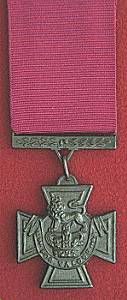The
Victoria Cross was instituted in 1856 by Queen Victoria, but was made retroactive to the
autumn of 1854 to cover the period of the Crimean War. In fact one of the fist Victoria
Crosses Awarded was to a Canadian, Lieutenant Alexander Roberts Dunn, who won his Victoria
Cross during the charge of the Light Brigade on 25 October 1854 at Balaclava. It takes
precedence over every other honor in the British empire including such illustrious orders
of knighthood and chivalry such as the Order of the Garter, Order of the Thistle, Order of
St. Patrick, etc.
The Victoria Cross was won by few aviators
during World War II. More common awards included the Distinguished Flying Cross, which
officers received for extraordinary service in air combat. Different medals existed for
officers than for enlisted men; a reflection of the caste system prevalent in British
society at the time. There are no specific
criteria for awarding of the VC, no one has actually defined "valor". In WWI
several pilots (including Raymond Collishaw) flying with the RNAS should have been awarded
the VC, as their exploits equaled those of RFC pilots, but they were typically downgraded
to DSOs. In WWII the awarding of VCs came much less often, especially to flyers, as the
novelty and apparent daring of their profession had worn off.
The Cross was created to recognize some
single, outstanding act of valor or devotion to the country performed in the presence of
the enemy. It was to consist of a Maltese Cross (in fact, a cross paté) of bronze made
from the metal from one of the Russian guns captured at Sebastopol, with the Royal Crest
in the center and underneath a scroll bearing the words "For Valour". On the
reverse side of the cross is engraved the date of the act of bravery while the name of the
recipient is engraved on the back of the clasp.
At first the ribbon was blue for the Navy and red for the Army. But by Royal Warrant of 22
May 1920, signed be the secretary of State for War, Winston Churchill, "the ribbon is
red for all services and when it only is worn, a small replica of the cross is fixed in
the center".
With the view of putting everyone on a perfectly equal footing for winning the decoration
it was ordained that neither rank nor long service nor wounds nor any other circumstance,
save the brave act itself, should be held to establish a sufficient claim to the honor. In
the case of conspicuous bravery on the part of a body of soldiers or sailors (and later
airmen), officer and other ranks had the privilege of selecting one or more of their
number for the honor. In earlier wars -- particularly the Indian Mutiny, a number of
awards were decided in this manner. later, the Practice died out almost completely.
A Bar to the Cross could also be awarded for another act of equal bravery. There have only
been three of these ever awarded, none to a Canadian. In total there have been 1,351
Victoria Crosses awarded to date to members of the Armed Forces of the British
Commonwealth, 93 of these are credited to Canadians. Only one has been awarded to a member
of the regiments' predecessors: L/Cpl. William Henry Metcalf, MM one of only 6 Americans
to receive the Victoria Cross, (of the 16 Battalion CEF later the Canadian
Scottish Regiment - (Princess Mary's)) at Arras, France
on 2 September 1918.
The largest number of Victoria Crosses awarded to one regiment in a single action is seven
out of a total of eleven awarded -- a Lieutenant, a corporal and five privates of the
South Wales Borderers, who were selected for the award after the engagement at Rorkes
Drift in the Zulu War of 1879. In the Gallipoli landings in 1915 the Lancashire Fuisiliers
won six VC's before breakfast. The youngest person to receive the award was fifteen years
old and the oldest was 69 at the time.
In recent years the Canadian Government created a series of distinctly Canadian awards for
both civilian and military achievements. As a consequence, the Victoria Cross, which is a
distinctly British award, was for a time no longer to be presented to Canadian soldiers,
sailors or airmen for valor in battle under normal circumstances.
More recently, however, the Victoria Cross has been reinstated as the highest possible
award for valor to a member of the Canadian Armed Forces. The Award was Canadianized when
it was reintroduced with the words on the scroll being changed from the English "For
Valour" to the Latin "Pro Valour" (meaning the same thing) as there was no
room to incorporate both official languages into the design. The Canadianized version of
the Cross will be struck from the same bronze as the original Crosses in the event that a
member of the Canadian Armed Forces earns this high honor in the future.
Since its inception, 1,350 have been
awarded, most frequently posthumously. |
 |
